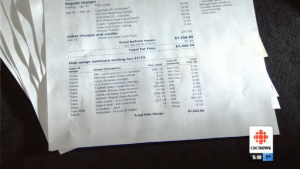Data roaming shock
 There are some real cases of data roaming bill shock. A lot of people really don’t know that it can get really expensive, really fast if a smart phone connects to a foreign data network.
There are some real cases of data roaming bill shock. A lot of people really don’t know that it can get really expensive, really fast if a smart phone connects to a foreign data network.
Many devices have settings to help avoid roaming bill shock.
One of the settings lets you disable the cellular radio; the other commonly found setting is to disable data roaming, but allow calls and text messages to come through. Both of these options will usually let you log in to WiFi hotspots at your hotel or coffee shops.
I actually think that devices should come pre-configured with data roaming disabled as the default setting.
For some reason, I am not feeling sympathetic to the latest story that was created by CBC’s Go Public. From the time I first heard about it, a number of questions ran through my mind.
CBC’s headline reads “Dad gets $22,000 data roaming ‘shock’ from Fido”.
In fact, there was no bill for $22,000. The kid used data that would have cost $22,000 if Rogers had not first adjusted the bill to reflect the prices that would have been charged if the parent had signed up for a discounted data plan. But that doesn’t attract eyeballs the same way.
The video clip that aired is introduced by an announcer who said:
A Burnaby man is going public tonight after getting a $22,000 phone bill.
That simply was not true. CBC was wrong. As it turns out, he never received a bill for $22,000. CBC knew that. In fact, CBC shows the bill in the video (the image reproduced here is from a freeze on the 1:08 mark of the CBC video). You can clearly see that the total bill, including regular monthly charges and tax comes to only $1400. That is a lot, but barely 5% of the headline.
From the bill, we can see that this is a family that was fully aware of possible data roaming charges. The bill shows a regular US data roaming subscription. In the story, the parent describes visiting the Apple store to find out how to avoid charges.
However, the 11 year-old son got a sunburn and was left in the hotel room with the family iPhone to play with. As the story goes, the kid turned on data roaming and spent 3 days watching YouTube videos.
Normally, a text message is sent to warn customers that welcomes the user to a foreign land and provides instructions on rates and how to manage roaming costs. For example, one of my phones recently received one that said:
Rogers TIP: You’re Roaming. Stay connected with an affordable and easy to use roaming offer. If you don’t already have one, simply click http://rogers.com/m/apac (no charge) to quickly view your options. Without a roaming offer, regular roaming rates are $3/min $0.75/txt $0.03/kB (+ taxes). FYI: Email, browsing, Visual Voicemail, MMS, IM, BBM & Apps use data. If you still require assistance please call Rogers free of charge at +1-514-734-7699
According to the article, no such message was received, although it is not known whether such an incoming message was deleted.
Contrary to the paragraph in the CBC story that claims “Currently, the only way for a customer to access data outside the country for less — through their carrier — is to buy a roaming package, before leaving”, you can subscribe to discounted data plans once you arrive in your destination.
The bill appears to reflect a substantial reduction in the charges that might otherwise have been incurred. We are told that the kid consumed 700MB of data over three days, two of which are on the current bill. From the vidcap of the bill, we can see that there is a line item for a 75 MB package plus overage charges for another 327 MB. That means that next months bill will have another 300 MB or so. This month’s data bill is $1200; next month, at the same rate, will be about $1000. It is a lot, but there is no bill for $22,000.
And contrary to the opening of the news story, there was no bill for $22,000. The author of the CBC story says that she isn’t responsible for the intro. In a tweet since removed, she wrote: “@CBCGoPublic: That was intro to story not written by me which aired hours ago. Story clearly stated $2200. I am done here.”
In fact, the story talks about $22,000 four times (plus the headline and the caption to the video) before you get to the 9th paragraph, where it states “Fido immediately said it would cut the bill to $2,200.” Cut the bill? There was no $22,000 bill. All evidence seems to be that the only bill that was sent was for $2200.
Just a sensational headline, under the banner of the national broadcaster, perhaps intended to influence CRTC members who are considering such matters as part of the Wireless Code of Conduct. It might have been interesting to hear if CBC asked the parents how they felt about leaving their child unattended in a Mexican hotel room for 3 days. Did CBC check the deleted messages folder to see if the warning text message was accidentally erased?
I am sympathetic to many cases of data roaming bill shock. This just isn’t one of them.
